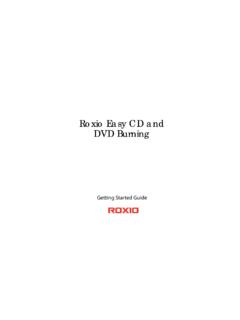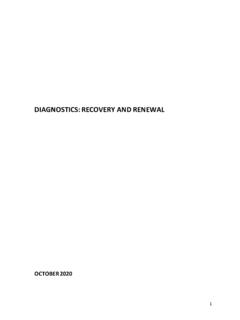Transcription of Pearson Edexcel Centre Number Candidate Number Level 3 …
1 Write your name here Surname Other names Centre Number Candidate Number Pearson Edexcel Level 3 GCE. Chemistry advanced Paper 3: General and Practical Principles in Chemistry Tuesday 27 June 2017 Morning Paper Reference Time: 2 hours 30 minutes 9CH0/03. Candidates must have: Data Booklet Total Marks Scientific calculator Ruler Instructions Use black ink or black ball-point pen. Centre Fill in the boxes at the top of this page with your name, Number and Candidate Number . Answer allthequestions. Answer there may bequestions in the spaces provided more space than you need.
2 Information The The total mark for this paper is 120. usemarks for each question are shown in brackets this as a guide as to how much time to spend on each question. For the question marked with an asterisk (*), marks will be awarded for your ability to structure your answer logically showing the points that you make are related or follow on from each other where appropriate. A Periodic Table is printed on the back cover of this paper. Advice Read each question carefully before you start to answer it. Try to answer every question. Check your answers if you have time at the end.
3 Show all your working in calculations and include units where appropriate. Turn over P48954A. 2017 Pearson Education Ltd. 6/6/6/1/. *P48954A0136*. Answer ALL questions. Write your answers in the spaces provided. DO NOT WRITE IN THIS AREA. 1 This question is about transition metal chemistry. (a) The amphoteric character of solid chromium(III) hydroxide is shown by the fact that it reacts separately with both dilute hydrochloric acid and dilute sodium hydroxide solution. (i) Write an ionic equation for the reaction of solid chromium(III) hydroxide with dilute hydrochloric acid, showing the formula of the complex ion formed.
4 Include state symbols in your answer. (2). DO NOT WRITE IN THIS AREA. (ii) Describe the changes you would see when the reaction in (a)(i) is carried out. (2).. (iii) Write an ionic equation for the reaction of solid chromium(III) hydroxide with dilute sodium hydroxide solution, showing the formula of the complex ion formed. Include state symbols in your answer. (2). DO NOT WRITE IN THIS AREA. (iv) State the final appearance of the reaction mixture in (a)(iii). (1).. 2. *P48954A0236*. (b) Dilute aqueous ammonia is added, drop by drop, to an aqueous solution of copper(II) sulfate until the aqueous ammonia is in excess.
5 DO NOT WRITE IN THIS AREA. (i) Describe what you would see during this experiment. (2).. (ii) The reaction between aqueous copper(II) sulfate and excess aqueous ammonia is an example of a ligand substitution reaction. Write an equation for the ligand substitution reaction that occurs, showing the formulae of the complex ions involved. State symbols are not required. (2). DO NOT WRITE IN THIS AREA. (Total for Question 1 = 11 marks). DO NOT WRITE IN THIS AREA. 3. *P48954A0336* Turn over 2 This question is about the preparation of a sample of the ketone, 3-methylbutan-2-one.
6 A student's research suggested that 3-methylbutan-2-one may be prepared by DO NOT WRITE IN THIS AREA. oxidising 3-methylbutan-2-ol with acidified potassium dichromate(VI) solution. The student sets up the apparatus as shown in the diagram. You may assume that all the equipment is suitably clamped. The student adds dilute sulfuric acid to the pear-shaped flask. A mixture of potassium dichromate(VI) and 3-methylbutan-2-ol is then added slowly to the dilute sulfuric acid in the flask. water from tap DO NOT WRITE IN THIS AREA. pear-shaped flask reaction mixture anti-bumping granules conical flask water to sink ice water mixture DO NOT WRITE IN THIS AREA.
7 4. *P48954A0436*. (a) Identify the two changes that must be made to the apparatus before heating the pear-shaped flask, giving a reason for each change. (4). DO NOT WRITE IN THIS AREA.. DO NOT WRITE IN THIS AREA. (b) Draw the skeletal formulae for 3-methylbutan-2-ol and 3-methylbutan-2-one. (2). 3-methylbutan-2-ol DO NOT WRITE IN THIS AREA. 3-methylbutan-2-one 5. *P48954A0536* Turn over (c) Once the essential changes are made to the apparatus, the pear-shaped flask is heated. The distillate formed is collected in the conical flask. DO NOT WRITE IN THIS AREA.
8 On testing the distillate with pH paper, it is found that its pH is 2. The student suggests that this pH is due to the formation of 3-methylbutanoic acid. (i) Give a reason why 3-methylbutanoic acid cannot be formed in the reaction. (1).. (ii) Deduce the formula of the compound that could cause the distillate to have a pH value of 2. (1). DO NOT WRITE IN THIS AREA. (iii) Solid sodium carbonate is added to the distillate. The sodium carbonate disappears and fizzing occurs. Write an equation, including state symbols, for the reaction that occurs between sodium carbonate and the compound you have identified in (c)(ii).
9 (2). DO NOT WRITE IN THIS AREA. 6. *P48954A0636*. (d) The organic mixture was separated from the aqueous layer and dried. The infrared spectrum of the organic mixture is shown. DO NOT WRITE IN THIS AREA. 100. transmittance (%). 50. 0. 4000 3000 2000 1500 1000 500. wavenumber / cm 1. DO NOT WRITE IN THIS AREA. (i) By reference to any relevant peak(s), deduce how the infrared spectrum shows that the mixture contains 3-methylbutan-2-one. (2).. (ii) From the infrared spectrum, the student concludes that the mixture contains another organic compound.
10 The mixture is redistilled and the fraction that boils in the range 93 95 C is collected. The boiling temperature of 3-methylbutan-2-one is 94 C. DO NOT WRITE IN THIS AREA. Predict any change(s) you would see in the infrared spectrum after redistillation, justifying your answer. (2).. 7. *P48954A0736* Turn over (e) The mass spectrum of pure 3-methylbutan-2-one is shown. DO NOT WRITE IN THIS AREA. 100. 80. relative intensity 60. 40. 20. 0. 10 20 30 40 50 60 70 80 90. m /z (i) State how you would find the molar mass of 3-methylbutan-2-one from the DO NOT WRITE IN THIS AREA.














